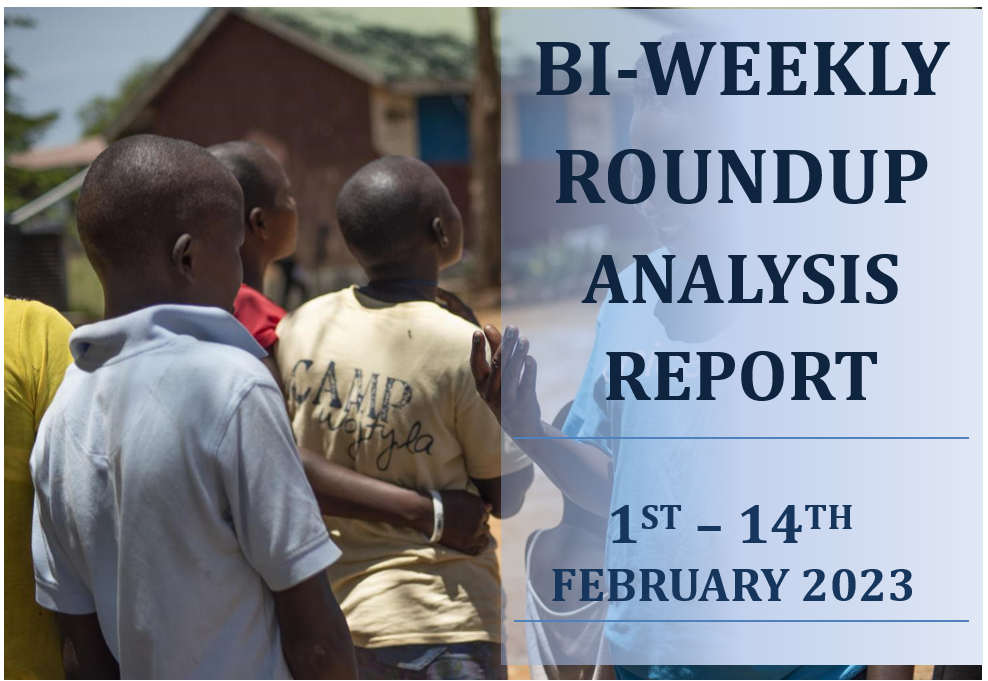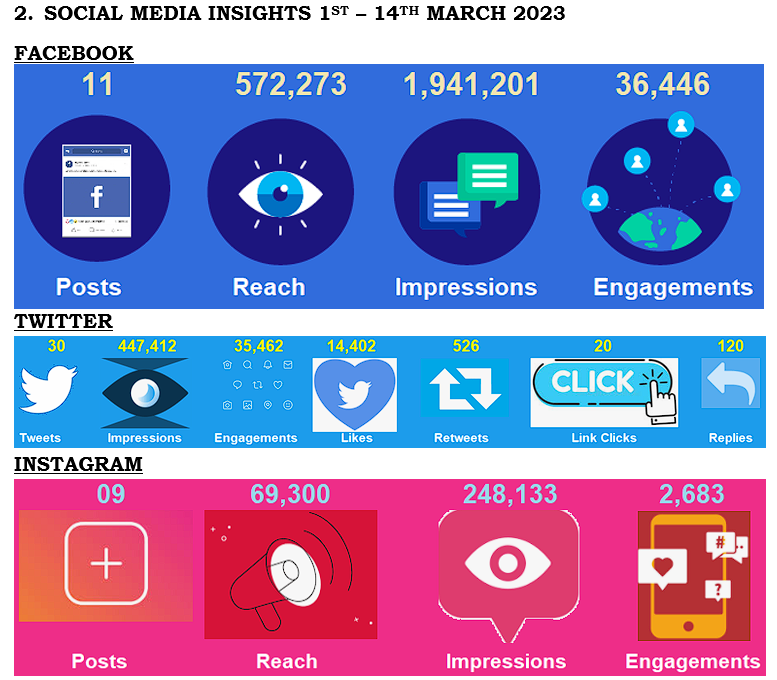


PREPARED BY

OVERVIEW
This report presents findings from the analysis of the coverage of children-related issues in Uganda for the period 1st – 14th February 2023 by various online media platforms. The main method used was content analysis.
Overall, the analyzed data results show that 694 stories were published online on children and children-related issues in Uganda, indicating an increase of 164 stories from those published during the last two weeks of January 2023.
Four hundred thirty five (435) stories focused on keeping children[1] learning[2], 178 on keeping children safe[3] while 81 were on keeping children alive.
BI-WEEKLY ANALYSIS OF EDITORIAL AND JOURNALISTIC REPORTING TRENDS BY ONLINE PUBLICATIONS ON CHILDREN IN UGANDA (FEBRUARY 1ST – 14TH 2023)
- INTRODUCTION
Ultimate Multimedia Consult (UMC) is required to present to UNICEF Uganda an analysis of editorial and journalistic reporting trends on children-related issues in online publications after every two weeks. This report presents findings on how online publications covered children-related issues for the first two weeks of February 2023.
The report also shows how UNICEF Uganda messages, including press releases, reports and expertise, are reported on by online publications. In addition, the report gives insights into the accuracy and appropriateness of the information provided on children’s issues.
The analyzed content was drawn from news websites based in Uganda like: NTV Uganda, NBS TV, Bukedde and Capital FM; other websites like: Daily Monitor, New Vision, Uganda Radio Network, ChimpReports, PML Daily, Nile Post and The Independent among others as well as websites based in other countries. The analyzed data was accessed from online publications/platforms.
- ONLINE ANALYSIS
We captured 694 articles from online publications reporting children-related issues during the first two weeks of February 2023 (1st – 14th) indicating an increase of 164 stories from those recorded during the last two weeks of January 2023. Below is a table showing a breakdown by publication, and category.
- CATEGORIES
Four hundred thirty-five (435) stories were centered on keeping children learning.
Issues on keeping children safe were reported in 178 stories.
Stories on keeping children alive were in 81 stories.
Graph showing the distribution of story articles in terms of categories

- GENDER OF AUTHORS
During the period under review, male authors reported and or wrote most stories. While some stories had more than one author, 177 stories had no authors specified.

SENTIMENT
We found 39% of the stories on children issues published online during the first two weeks of February 2023 had a positive sentiment[4]. Children-related stories with neutral sentiment were the least.

Out of the 247 children-related stories we recorded having negative sentiments, 0ne (01) storymentioned UNICEF. The mention was in the article below:
- https://www.eeas.europa.eu/eeas/over-4-million-girls-risk-mutilation_en Over 4 million girls at risk of mutilation
- SHARE OF VOICE
Majority of the stories recorded during the first two weeks of February 2023 had a high share of voice[5] on children and children-related issues.

- TYPE OF COVERAGE
The graph below shows the type of coverage of children-related stories online during the period 1st – 14th February 2023

- MESSAGE FIDELITY
Majority (81%) of the children-related stories recorded during the first two weeks of February 2023 had high message fidelity. This implies that they laid out their messages clearly, through the use of facts, statistics, audio-visuals and sources, making it easy for users to understand them as intended by authors. Such stories are credible and trusted by content consumers.

- NATURE OF QUOTES
Out of the 694 children-related stories we recorded from online publications, 550 stories had direct quotes indicating journalists’ sourcing and clarity in presenting news. Six (06) stories had no quotes.

- USE OF VISUALS
In the stories recorded during this period, 685 hadaudio–visuals (photos, videos, audio and graphics). Eight (08) stories had no audiovisuals as shown below.

Stories with visuals are understood much more than those without.
- ISSUES COVERED
The graphic below shows the topics covered in children-related stories online. The size of the words in the figure below and the numbers shown in the brackets (after the graphic) reflect the frequency at which the various topics were reported on in online publications.

From the stories captured, we noted that the issues of Education (167 times), examinations (153 times) were the most covered during this period. These were followed by:
- Schools (144)
- Child protection (73)
- Child health (39)
- School fees (32)
- Teaching (25)
- Homosexuality (24)
- Parenting (22)
- Children with Disability (21)
- Defilement (18)
- Female Genital Mutilation (FGM) (17)
- WASH (14)
- Child torture (12)
- Child trafficking (25)
- Note that some stories covered more than one issue
- STORIES DISTRIBUTION PER REGION

Most (179) of the stories recorded were from the Central region while the Western region had the least stories at 38 as represented on the graph above.
While some stories cut across different districts, others were general in nature and therefore were not recorded as coming from any of the four regions of Uganda.

From the figure above, Kampala District had the highest coverage with 73 stories.
Wakiso (35), Sembabule (1), Rakai (1), Nakaseke (3), Mukono (15), Mpigi (2), Masaka (11), Lwengo (4), Luweero (5), Kyotera (3), Kyankwanzi (1), Kiboga (1), Kayunga (5), Kassanda (3), Kalungu (2), Kalangala (2), Gomba (2), Buikwe (3), Mubende (5), Bukomansimbi (2),

Tororo (5), Soroti (6), Pallisa (3), Ngora (1), Namisindwa (1), Mbale (6), Kibuku (1), Katakwi (3), Kamuli (7), Jinja (11), Iganga (2), Buyende (1), Butaleja (8), Busia (4), Bukedea (3), Bugweri (1), Budaka (2)

Rwampara (1), Rukungiri (3), Ntungamo (1), Mbarara (1), Bunyangabu (1), Masindi (1), Kyegegwa (1), Kitagwenda (2), Kiruhura (5), Bundibugyo (1), Kikuube (1), Kasese (3), Kanungu (2), Kamwenge (1), Kakumiro (6), Kagadi (1), Kabale (2), Isingiro (2), Ibanda (1), Hoima (2)

Zombo (1), Nwoya (3), Nebbi (4), Napak (3), Nakapiripiriti (1), Moroto (4), Maracha (1), Madi-Okollo (2), Lira (1), Lamwo (2), Kwania (1), Kotido (4), Koboko (4), Kole (1), Kitgum (2), Gulu (4), Arua (7), Adjumani (1), Amuru (2)
- UNICEF UGANDA WEBSITE ARTICLES
This part analyzes UNICEF Uganda messages, including press releases, reports and expertise, and how they are reported on by UNICEF Uganda website.
During the first two weeks of February 2023, one (01) article was published on the UNICEF Uganda website.
| Story link & title | Search Engine Optimization (SEO)[6] | Comments | |
| 1. | https://www.unicef.org/uganda/stories/upshift-helps-young-people-upskilled-fight-climate-change-northern-uganda UPSHIFT helps young people upskilled to fight climate change in northern Uganda | PhotosGood use of keywords | Outbound and inbound links on keywords and characters in your articles can make them stand out in Google searches. Keywords can also be included as tags.Headlines can also be made keyword-rich to make articles more searchable and attract readers’ attention.Use of videos in the articles is commendable as it provides extra information on the topic as well as rich media.Exploit other visuals like graphics and animations whenever possible. Multimedia articles are not only easy to understand but also stand out in online searches.Use of block quotes, bolding key phrases and putting some parts of the article in list form makes it scannable and easy to read |
- UNICEF MENTIONS
During this period, UNICEF was mentioned 20 times out of the 694 children-related stories in online publications. Below are links to the stories where UNICEF was mentioned during the first two weeks of February 2023:
HIV/AIDS
- https://eagle.co.ug/2023/02/01/uganda-11-african-health-ministers-unite-to-end-aids-in-children.html Uganda, 11 African Health Ministers unite to end AIDS in Children
- https://healthpolicy-watch.news/african-leaders-vow-to-end-aids-in-children-by-2030/ African Leaders Vow to End AIDS in Children by 2030
- https://www.who.int/news/item/01-02-2023-african-leaders-unite-in-pledge-to-end-aids-in-children African leaders unite in pledge to end AIDS in children
- https://www.newzimbabwe.com/african-leaders-urged-to-renew-commitment-to-ending-aids-in-children-by-2030/ African leaders urged to renew commitment to ending AIDS in children by 2030
- https://www.kenyanews.go.ke/african-countries-unite-to-curb-hiv-aids-among-children-by-2030/ African Countries Unite To Curb HIV/AIDS Among Children By 2030
- https://menafn.com/1105546704/African-Leaders-Unite-In-Pledge-To-End-AIDS-In-Children African Leaders Unite In Pledge To End AIDS In Children
FEMALE GENITAL MUTILATION
- https://www.globalcitizen.org/en/content/fgm-milestones-end-female-genital-mutilation/ 8 Huge Milestones to Celebrate in the Fight Against FGM
- https://www.eroicafenice.com/notizie-attualita/6-febbraio-giornata-contro-le-mutilazioni-genitali-femminili/ February 6: Day against Female Genital Mutilation
- https://www.eeas.europa.eu/eeas/over-4-million-girls-risk-mutilation_en Over 4 million girls at risk of mutilation
- https://www.lavanguardia.com/vida/20230206/8735986/aecid-colabora-programa-internacional-mutilacion-genital-femenina.html The Aecid collaborates in an international program against female genital mutilation
- https://lavocedinewyork.com/onu/2023/02/06/mutilazioni-genitali-femminili-lonu-con-litalia-per-zero-mgf-entro-2030/ Female genital mutilation: the UN with Italy for “zero FGM” by 2030
- https://unric.org/da/den-internationale-dag-for-nultolerance-overfor-kvindelig-omskaering/ The International Day of Zero Tolerance for Female Genital Mutilation
- https://worldtimetodays.com/the-world-needs-to-stop-female-genital-mutilation/ The world needs to stop female genital mutilation
EDUCATION
- https://news.ok.ubc.ca/2023/02/05/the-boy-who-carried-books-part-i/ The Boy Who Carried Books: Part I
- https://www.aceprensa.com/educacion/ensenanza/buenas-practicas-para-mejorar-la-educacion-en-las-regiones-pobres/ Good practices to improve education in poor regions
- https://nilepost.co.ug/2023/02/11/rose-academies-ngo-gives-new-lease-of-life-to-marginalised-girls-through-education/ Rose Academies: NGO gives new lease of life to marginalised girls through education
OTHER MENTIONS
- https://reliefweb.int/report/uganda/unicef-uganda-humanitarian-situation-report-no-6-end-year-january-december-2022 UNICEF Uganda Humanitarian Situation Report No. 6 (End of Year) January – December 2022
- https://www.monitor.co.ug/uganda/magazines/healthy-living/good-nutrition-must-start-early-4121396 Good nutrition must start early
- https://www.independent.co.ug/kicking-out-human-rights/ Kicking out human rights
- https://dailyexpress.co.ug/2023/02/03/babies-above-six-months-predominantly-breastfed-are-prone-to-anaemia/ Babies above six months predominantly breastfed are prone to anaemia
- COMPARATOR MENTIONS
The Ministry of Education & Sports (MoES) was the most mentioned comparator in 76 stories, followed by the World Health Organisation (WHO), with 20 and the Ministry of Health (MoH) with 16 among other comparators.
Below is a breakdown of all comparator mentions
| COMPARATOR | NUMBER OF MENTIONS |
| Ministry of Education & Sports (MoES) | 76 |
| World Health Organization (WHO) | 20 |
| Ministry of Health (MoH) | 16 |
| United Nations (UN) | 10 |
| United Nations Population Fund (UNFPA) | 7 |
| The United Nations Educational, Scientific and Cultural Organization (UNESCO) | 7 |
| Ministry of Gender, Labour and Social Development | 6 |
| Uganda Women’s Effort to Save Orphans (UWESO) | 5 |
| Office of the United Nations High Commissioner for Human Rights (OHCHR) | 5 |
| Windle International Uganda | 4 |
| USAID | 4 |
| World Bank | 3 |
| World Food Program (WFP) | 3 |
| Uwezo Uganda | 3 |
| World Vision | 2 |
| United Nations High Commissioner for Refugees (UNHCR) | 2 |
| United Nations Development Programme (UNDP) | 2 |
| Compassion International | 2 |
| Child Fund Uganda | 2 |
| International Labour Organisation (ILO) | 1 |
| International Organization for Migration (IOM) | 1 |
| Food Agriculture Organisation (FAO) | 1 |
| European Union | 1 |
| Action Against Hunger | 1 |
| Action Aid | 1 |
| Center for Health, Human Rights and Development (CEHURD) | 1 |
| Rotary International | 1 |
| The Joint United Nations Programme on HIV/AIDS (UNAIDS) | 1 |
- SOCIAL MEDIA INSIGHTS 1ST – 14TH FEBRUARY 2023



YOUTUBE


- SOCIAL MEDIA TRENDS
This part looks at how different media organizations in Uganda posted about children-related issues on social media. During this period, NTV Uganda, The New Vision, NBS TV and Daily Monitor posted the most on children. Posting was mainly on aspects of education, girl child, examinations, UCE results, pediatrics, child malnutrition, teaching, child murder, child health, teachers, street children, school reopening, school feeding, COVID19, menstrual health, school requirements, school fees, child marriage, teenage pregnancy and other sex-related offences against children, reproductive health, maternal and neonatal health, child protection, parenting and violence against children, among others. Below are snippets from and links to the posts captured from social media:


https://www.instagram.com/p/CoKAu3EtubS/




https://www.instagram.com/p/CoOuCjboOuv/



https://www.instagram.com/p/CoR2KWIuXWx/

https://www.instagram.com/p/CoRLsvgNPIc/



https://www.instagram.com/p/CoThkNUsZn9/









https://www.instagram.com/p/CoeMxhcOq1R/

https://www.facebook.com/NTVUganda/photos/a.319879798060481/6037509599630777/

https://www.facebook.com/NTVUganda/photos/a.319879798060481/6037427592972311


https://www.instagram.com/p/CohB4XTtM-8/

https://www.instagram.com/p/Cojp63Bt7f3/







[1] This is concerned with stories and journalistic content which addresses the health of children in Uganda. It may also entail stories that look at the welfare of pregnant mothers or maternal health in general.
[2] Reports categorized as such may connote content published in a context of improving and addressing the issues concerning both informal and formal education of a child, including early and progressive learning.
[3] Stories in this category may refer to a journalistic report(s) written and presented in the context of the social safety and welfare including the security of a child. Such stories include any content that addresses issues that threaten the lives of children like physical assault, psychosocial injury and threat.
[4] Sentiment (also known as tonality) is used to measure how messages contained in children related stories are portrayed in the media in relation to UNICEF’s mission to advocate for the protection of children’s rights, help meet their basic needs and expand their opportunities to reach their full potential. Sentiment is normally categorized as positive, neutral or negative.
[5] The measure of the publicity/exposure a brand or issue receives in a story compared to its competitors or other issues.
[6] Search Engine Optimization is the process of improving the content on your website to increase its visibility for relevant searches online.



